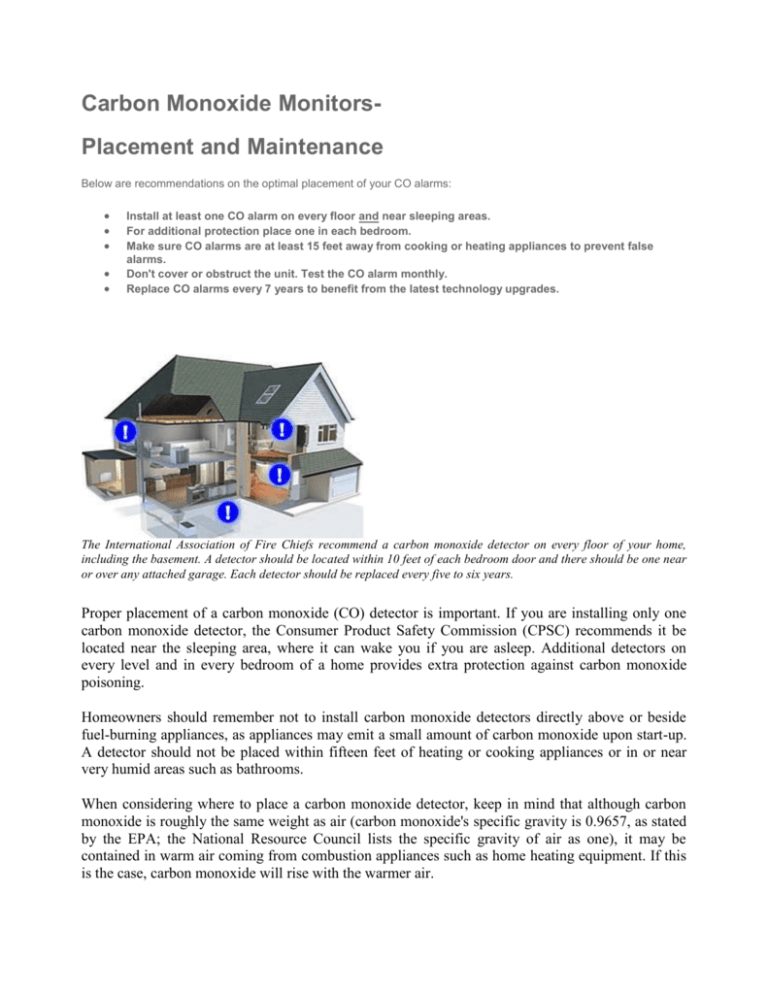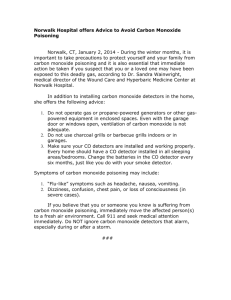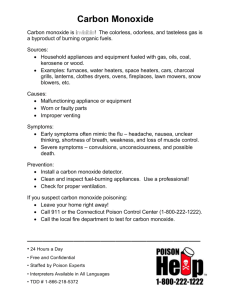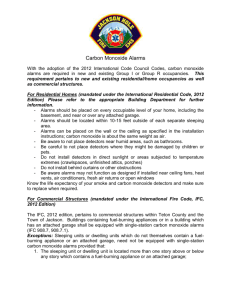Carbon Monoxide Monitors – Installation
advertisement

Carbon Monoxide MonitorsPlacement and Maintenance Below are recommendations on the optimal placement of your CO alarms: Install at least one CO alarm on every floor and near sleeping areas. For additional protection place one in each bedroom. Make sure CO alarms are at least 15 feet away from cooking or heating appliances to prevent false alarms. Don't cover or obstruct the unit. Test the CO alarm monthly. Replace CO alarms every 7 years to benefit from the latest technology upgrades. The International Association of Fire Chiefs recommend a carbon monoxide detector on every floor of your home, including the basement. A detector should be located within 10 feet of each bedroom door and there should be one near or over any attached garage. Each detector should be replaced every five to six years. Proper placement of a carbon monoxide (CO) detector is important. If you are installing only one carbon monoxide detector, the Consumer Product Safety Commission (CPSC) recommends it be located near the sleeping area, where it can wake you if you are asleep. Additional detectors on every level and in every bedroom of a home provides extra protection against carbon monoxide poisoning. Homeowners should remember not to install carbon monoxide detectors directly above or beside fuel-burning appliances, as appliances may emit a small amount of carbon monoxide upon start-up. A detector should not be placed within fifteen feet of heating or cooking appliances or in or near very humid areas such as bathrooms. When considering where to place a carbon monoxide detector, keep in mind that although carbon monoxide is roughly the same weight as air (carbon monoxide's specific gravity is 0.9657, as stated by the EPA; the National Resource Council lists the specific gravity of air as one), it may be contained in warm air coming from combustion appliances such as home heating equipment. If this is the case, carbon monoxide will rise with the warmer air. Installation locations vary by manufacturer. Manufacturers' recommendations differ to a certain degree based on research conducted with each one's specific detector. Therefore, make sure to read the provided installation manual for each detector before installing. CO detectors do not serve as smoke detectors and vice versa. However, dual smoke/CO detectors are also sold. Smoke detectors detect the smoke generated by flaming or smoldering fires, whereas CO detectors can alarm people about faulty fuel burning devices to prevent carbon monoxide poisoning. Carbon monoxide is produced from incomplete combustion of fossil fuels. In the home CO can be formed, for example, by open flames, space heaters, water heaters, blocked chimneys or running a car inside a garage. Since CO is colorless, tasteless and odorless (unlike smoke from a fire), detection and prevention of carbon monoxide poisoning in a home environment is impossible without such a warning device. In North America, some state, provincial and municipal governments require installation of CO detectors in new units - among them, the U.S. states of Illinois, Massachusetts, Minnesota, New Jersey, and Vermont, the Canadian province of Ontario, and New York City. According to the 2005 edition of the carbon monoxide guidelines, NFPA 720, published by the National Fire Protection Association, sections 5.1.1.1 and 5.1.1.2, all CO detectors 'shall be centrally located outside of each separate sleeping area in the immediate vicinity of the bedrooms,' and each detector 'shall be located on the wall, ceiling or other location as specified in the installation instructions that accompany the unit.' When carbon monoxide detectors were introduced into the market, they had a limited lifespan of 2 years. However technology developments have increased this and many now advertise 5 or even 6 years. Newer models are designed to signal a need to be replaced after that timespan although there are many instances of detectors operating far beyond this point. Although all home detectors use an audible alarm signal as the primary indicator, some versions also offer a digital readout of the CO concentration [see side-bar], in parts per million. Typically, they can display both the current reading and a peak reading from memory of the highest level measured over a period of time. The digital models offer the advantage of being able to observe levels that are below the alarm threshold, learn about levels that may have occurred during an absence, and assess the degree of hazard if the alarm sounds. They may also aid emergency responders in evaluating the level of past or ongoing exposure or danger of carbon monoxide poisoning. Battery-only carbon monoxide detectors tend to go thru batteries more frequently than expected. Plug-in detectors with a battery backup (for use if the power is interrupted) provide less batterychanging maintenance. Some CO detectors are available as system-connected, monitored devices. System-connected detectors, which can be wired to either a security or fire panel, are monitored by a central station. In case the residence is empty, the residents are sleeping or occupants are already suffering from the effects of CO, the central station can be alerted to the high concentrations of CO gas and can send the proper authorities to investigate possible carbon monoxide poisoning.








